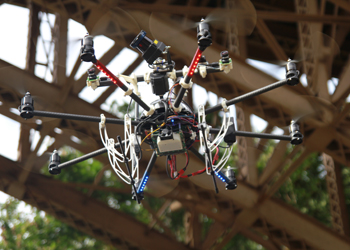Press Release: National Robotics Initiative Awards Provide $7 Million for Carnegie Mellon Research Projects
Researchers Developing Robots for Bridge Inspection, Mine Rescue, Aid for the Blind
Contacts: Byron Spice / 412-268-9068 / bspice@cs.cmu.edu
Chriss Swaney / 412-268-5776 / swaney@andrew.cmu.edu
 PITTSBURGH—Robotic rotorcraft for inspecting bridges and other infrastructure, tools for minimally invasive surgery that guide surgeons by creating 3D maps of internal organs and assistive robots for blind travelers are among seven new Carnegie Mellon University research projects sponsored through the National Robotics Initiative.
PITTSBURGH—Robotic rotorcraft for inspecting bridges and other infrastructure, tools for minimally invasive surgery that guide surgeons by creating 3D maps of internal organs and assistive robots for blind travelers are among seven new Carnegie Mellon University research projects sponsored through the National Robotics Initiative.
The National Science Foundation announced it has awarded a total of more than $7 million to Carnegie Mellon researchers in the latest round of grants for the initiative — a multi-agency effort to develop robots that can work with humans to extend and augment human skills. U.S. President Barack Obama announced the National Robotics Initiative at Carnegie Mellon in 2011.
"The great promise of robots is to extend human skills and enhance human lives," said Matt Mason, director of the Carnegie Mellon Robotics Institute. "The National Robotics Initiative is helping researchers here at Carnegie Mellon and across the country make that promise a reality."
Among the new projects is a large, multi-university, interdisciplinary effort led by Sanjiv Singh, research professor in the Robotics Institute, to develop an autonomous robotic inspection assistant. The goal is to improve the assessment of aging bridges and other critical infrastructure by combining human judgment with machine intelligence.
"Current inspection methods for bridges, dams and other infrastructure often require expensive, specialized equipment and are potentially dangerous for inspectors who must reach difficult-to-access areas," Singh said. "This project will use small, low-flying robots, coupled with 3D imaging and advanced planning, modeling and analysis, to provide safe, efficient and high-precision assessment of critical infrastructure."
In addition to other members of the Robotics Institute, the three-year, $2.3 million project will include researchers in the departments of Civil and Environmental Engineering at CMU and Northeastern University.
Howie Choset, professor of robotics, is a co-principal investigator in another large, multi-university project that will provide surgical robots with a new kind of machine intelligence that will enhance minimally invasive surgery. The five-year, $3.6 million project includes researchers at Vanderbilt University and Johns Hopkins University.
The researchers will work to establish the concept of "complementary situational awareness," which takes advantage of a robot's ability to gather sensory information as it works and to use that information to guide its action. In particular, they hope to compensate for a surgeon's inability to directly see organs and other tissues when they are performing minimally invasive surgery, which is performed through small incisions using devices that provide only a narrow view of the surgical site.
Researchers led by Choset will use a technique called simultaneous localization and mapping, or SLAM, which allows mobile robots to navigate unexplored areas by creating maps as they go. This class of algorithms was developed for navigating buildings, landforms and streets, so Choset's team will extend the technique to work in the pliable tissues of the body.
Other NRI projects at Carnegie Mellon include:
- Researchers led by M. Bernardine Dias, associate research professor of robotics, will use small, wheeled robots, a two-armed Baxter robot and other devices to find ways to help visually impaired people safely travel and navigate through unfamiliar environments.
- Steve Collins, professor of mechanical engineering, will lead a five-year project comparing different techniques for assisting individuals with stroke-related mobility impairments using robotic ankle orthotics.
- A team led by William "Red" Whittaker, professor of robotics, will develop autonomous robots with radars, lasers and other advanced sensors that can serve as scouts for rescuers responding to underground mine disasters.
- Metin Sitti, professor of mechanical engineering and robotics, will develop methods for modeling, design and control of a large number of magnetic mobile micro-robots; if successful, micro-robotic systems might be designed for use in health care, micro-fluidic chips and desktop micro-manufacturing applications.
- Alonzo Kelly, professor of robotics, will lead a four-year effort to develop better simulation tools for designing and testing robot systems.
###
Among the new projects is an autonomous, low-flying robot with 3D imaging (pictured above) that will provide safe, efficient and high-precision assessment of critical infrastructure.